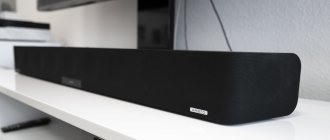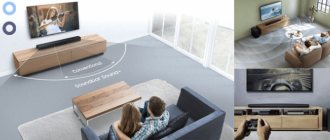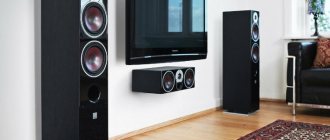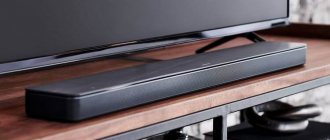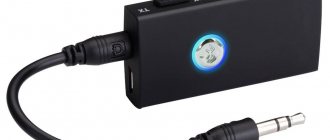Technologies
Anyone knowledgeable about audio technology will notice that the left and right channels of the soundbar are separated by a very short distance. A natural manifestation of this feature is the weakening of the stereo effect.
Manufacturers understand this and use many technological solutions in soundbars to improve the stereo effect:
- The different orientations of the front and side speakers are designed to use the reflection of sound from the walls, ceiling and floor of the room to create “virtual” side speakers. A simple solution, but not the most effective - the sound quality of such a soundbar greatly depends on the shape and size of the room.
- SDA technology also uses multiple speakers per channel; one of the side speakers generates sound in antiphase to one of the speakers on the other side. This requires large computing power, but at the same time allows for maximum separation of imaginary sound sources
The claim that a soundbar can create surround sound often causes outright skepticism - how can an audio system without rear speakers do this? Skeptics somehow miss the point that the audio system of the person himself (his ears) is stereophonic, and not surround at all. We do not have ears on the forehead or on the back of the head, so we get the idea of whether the sound source is behind or in front, above or below thanks to the “processor” processing of the sounds heard by the left and right ears. The ears distort sound coming from different directions in different ways, the brain “knows” this, and, analyzing the distortions, determines the direction to the sound source.
Having a mathematical model of sound distortion in the ear canals and in the head, you can use a conventional stereo system to create an imaginary sound source at any point in space. This mathematical model is called HRTF (Head Related Transfer Function).
The technology that uses HRTF to create surround sound is complex and expensive to implement, but its use allows a stereo system without rear speakers to create imaginary sound sources anywhere in space.
Now let’s “go back to earth.” All these technologies greatly increase the cost of the device, so many soundbars are just a pair of small speakers in one long case and you shouldn’t expect better sound from them than from a similar pair of regular speakers.
Even such an important indicator as the number of channels, when applied to sound bars, says little about the quality and volume of sound. Therefore, when choosing a soundbar, you need to clearly understand what you want to get - at least some improvement in TV sound, a high-quality stereo system, or a replacement for a home theater? And select the characteristics of the soundbar taking into account the desired result.
Is it better to choose a soundbar or speaker system?
The speaker system consists of a set of wired or wireless speakers. The former connect to the sound source via an audio input or USB port; the second - via Wi-Fi or Bluetooth. These can be simple computer stereo speakers or expensive high-end and hi-fi acoustics. The cost of different models depends on their functionality: some of them have a screen and you can connect a microphone for karaoke. Such systems can be located in different ways: on shelves, on the floor, on the wall, and also built into the wall. Their disadvantages are that they take up a lot of space, if placed incorrectly, they do not transmit sound very well, and they are also difficult to fit into the interior.
The “sounding crossbar” is easier to install, cheaper, fits better into the interior and is a kind of intermediate option between the built-in acoustics of gadgets and a multi-channel acoustic system.
How to add a subwoofer to a sound projector
On the one hand, all other things being equal, a soundbar obviously sounds better than a TV.
On the other hand, the “refinement” of the soundbar’s geometry still does not allow it to produce full-bodied bass. This issue can be resolved by adding a subwoofer. We also note that many modern models are initially equipped with a wireless subwoofer, which can be conveniently placed anywhere in the room.
If its use is undesirable for some reason, then you can find a sound bar with good low-end output. But such a model, as a rule, has a large body. Naturally, the subwoofer can be subsequently purchased and connected separately - usually such a possibility is provided in the soundbar switching, as, for example, in these models.
But in most cases, the sound bar is initially equipped with a subwoofer. This option is preferable, if only because the correct pairing (“stitching”) of the sound of these two acoustic systems is not an easy task. It is much better if this has already been done by the manufacturer. In addition, the supplied subwoofer is always correctly connected to the soundbar, eliminating possible errors - another reason for unnecessary hassle.
The option of switching the subwoofer and soundbar is worth paying special attention to. There are two options for subwoofers: active (with a built-in amplifier) and passive. In the first option, the signal to the device can still go both via cable and via a radio channel (wireless subwoofer).
Depending on this, the signal and power cables will be routed in one way or another. From an acoustic point of view, the correct location of the subwoofer in the room is usually found empirically.
And the coincidence of this point with the requirements of the interior is like winning the lottery.
Recommendations when choosing
- The first question to answer is, do you need a soundbar? It can be replaced by a home theater with better sound quality. However, the soundbar has a number of advantages, including compactness and a lower price. Therefore, in a small room with limited space, a soundbar is an ideal option;
- A small built-in subwoofer cannot fully replace the same option, but in a larger version, so it is recommended to buy a separate one for the soundbar;
- It is important to know for what purposes it will be used and what to pay more attention to - sound quality or broad functionality. The cost of the soundbar will depend on this.
Watch a video on how to choose a soundbar
Possible problems with switching: “turn it on and forget it”
Let's imagine this situation: in addition to a new TV, a new soundbar was purchased, and a subwoofer was purchased for it, and all this is “connected by wires.” And so the user turns on the TV, turns off its sound (now it is not needed), instead turns on the soundbar, adjusts the sound (volume, timbre, spatial characteristics, DSP processing), then we adjust the mutual sound of the subwoofer and soundbar... Not even half an hour passes, and he have already received powerful, high-quality sound. And this happens every time?!
This situation means that the soundbar and TV are connected incorrectly - such a possibility, alas, is not excluded. The optimal option for connecting a soundbar to a TV is HDMI switching using ARC.
This system is supported by almost all modern equipment, but when purchasing, you should make sure that all components have it. When using the ARC channel, the soundbar's sound is adjusted only once, after which its remote control is no longer needed in everyday use.
The soundbar turns on based on a signal from the TV, and the volume is adjusted from the TV remote control and is correctly displayed on its screen. The operation of the subwoofer is completely controlled by the soundbar. That is, with the installation of a soundbar, with proper switching and configuration, nothing changes for the user in the daily management of the system.
Rating of the best budget models
We offer you a rating of the best budget soundbar models.
Samsung HW-M360 - the cost of this device does not exceed 13 thousand rubles.
The power is 200 W, which means it is designed for a small room, it weighs only 1.5 kg and can easily be mounted on drywall. The mounting bracket is included in the box.
The included subwoofer weighs 4.6 kg. with bluetooth connection.
Connecting the entire set is similar, but here everything depends on the TV you have.
Use the stereo line input or optical digital input for high-quality sound.
To control the panel, a remote control is used, but it also receives signals from the TV remote control.
The downside is that there is no HDMI or Wi-Fi. It does not have a CD drive or a USB connector, so it simply cannot play content on its own.
LG-SJ3 - The acceptable price-quality ratio was enjoyed by many users of this device.
The total total power is 300 W, 200 of which comes from the subwoofer, and the remaining 100 from the panel itself.
The model will cost only 12 thousand rubles.
The subwoofer connects via Bluetooth and only needs an outlet for power.
Control via remote control.
It is recommended to connect to the TV with an optical cable.
SONY HT-CT290 - will provide powerful high-quality sound.
Costs no more than 15 thousand rubles.
Synchronization via TV cable is also controlled from the remote control.
Despite its compactness, the subwoofer creates quite comfortable bass and a nice design. Available in black and white colors.
When choosing budget models, we recommend choosing this one.
What else can a soundbar do?
The remaining switching options provided in soundbars are: optical input (required for TVs that do not support ARC and other digital signal sources), analog input (usually a 3 mm jack, necessary for working with any portable device).
Often soundbars have a USB connector and can directly play audio files from any flash drive. Less commonly, an FM tuner is included; sometimes the device also has a digital clock, can be turned on using a built-in timer and can work as a musical alarm clock - a good option, say, for a bedroom.
Typically, a modern soundbar can stream audio via Bluetooth. All this allows you to use the soundbar as a regular stereo system, and in terms of power, many models are capable of producing quite decent sound pressure “to the envy of their neighbors.”
If we talk about the most advanced models, they can contain a variety of additional devices, including BluRay players, media players, docking stations for Apple gadgets and even karaoke - here everyone can choose a device according to their own needs.
At the same time, the main advantages of a soundbar are a radical improvement in the sound of the TV, with a minimum of space taken up.
What connection methods are there?
When it is already clear exactly how to position the soundbar, it is worth thinking about how to connect the TV and other devices to it. In the case of a wall mount, you should first connect everything, and then hang the audio device.
The digital coaxial input can be used to connect Blu-ray, DVD players and other digital sources that have this output. If they don't have a coaxial output, they most likely have optical or equivalent. Another connection option is a 3.5 mm minijack . It either replaces the analog stereo inputs or is adjacent to them. The minijack is convenient for connecting portable digital audio devices. But they can also be connected using an RCA-minijack adapter, which is sold separately.
Using the HDMI input, you can transfer video signals from DVD/BD players and set-top boxes to your TV via the soundbar. The soundbar passes the video signal through itself without changing it in any way, but pulls out the sound from the broadcast and decodes/processes it independently. This solution reduces the mess of wires: there is no need to connect the TV with a separate cable to both the video source and the soundbar. Moreover, the soundbar is capable of supporting HDMI ARC (Audio Return Channel) - then the TV sends an audio signal using the same HDMI cable that the speakers use to transmit video to the TV (for versions older than 1.4a). This again reduces the number of cables required.
Many soundbars have a subwoofer output . If the soundbar you're customizing has one, you can physically connect an external subwoofer to it. Very often, subwoofers are needed as low-frequency support for a fuller sound. And although soundbars often come with a subwoofer, some are not burdened with it.
Many soundbars that come with a subwoofer connect to the subwoofer wirelessly to reduce the number of cables needed, even if they have the required connector. Another connection option is an Ethernet port . Soundbars with this connector can be connected to your home network, and through it to streaming services. Or even implement it into a multi-room system. Often, soundbars with an Ethernet port are equipped with Wi-Fi, which, again, does not require cables.
If your soundbar comes with a subwoofer, you need to find a suitable location for it. It must be located, firstly, conveniently (that is, next to the outlet), and secondly, so that it sounds. A properly installed subwoofer should sound at the same volume level as the soundbar.
LG SH5B
The LG SH5B 3D soundbar offers 2:1 stereo sound and supports a wide range of playback sources. In addition to adaptive sound control, the user is provided with an equalizer with a set of presets. The soundbar turns on automatically after detecting a signal source. After the source is turned off, the device automatically goes into sleep mode.
The functions of automatic volume control, audio and video synchronization, night mode, USB Host are provided. In addition to the standard remote control that comes included, a TV controller can be used for control. The soundbar display may turn off automatically.
The system is covered in matte black plastic with chrome trim. Below you can see 2 rubber feet for installation on a horizontal surface. The front panel of the soundbar is covered with a metal grille, behind which you can see the outlines of 4 speakers (2 on each side), an infrared receiver and an indicator.
The subwoofer body is made of wood, but the back panel is made of plastic. The woofer is hidden behind a fabric stretched over a wooden frame.
